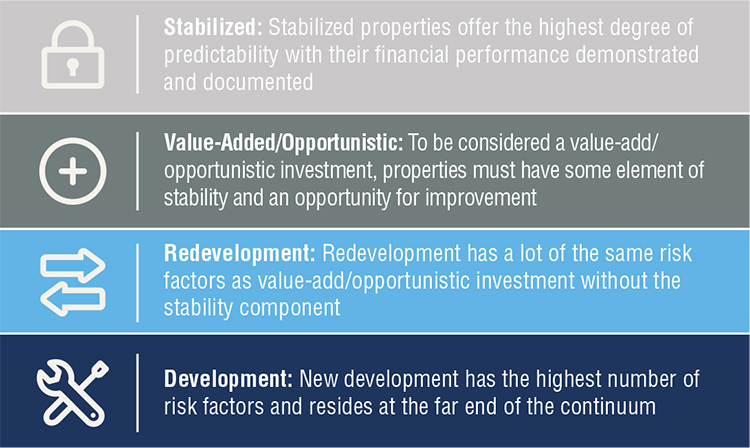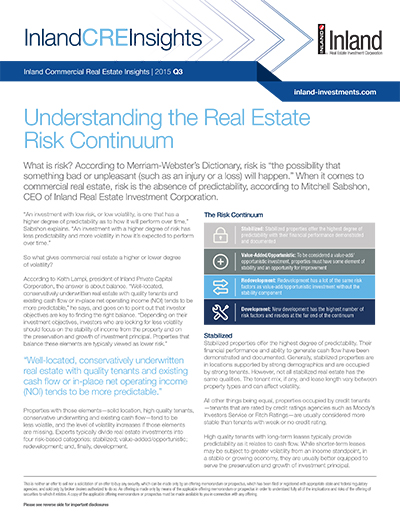What is risk? According to Merriam-Webster’s Dictionary, risk is “the possibility that something bad or unpleasant (such as an injury or a loss) will happen.” When it comes to commercial real estate, risk is the absence of predictability, according to Mitchell Sabshon, CEO of Inland Real Estate Investment Corporation.
“An investment with low risk, or low volatility, is one that has a higher degree of predictability as to how it will perform over time,” Sabshon explains. “An investment with a higher degree of risk has less predictability and more volatility in how it’s expected to perform over time.”
So what gives commercial real estate a higher or lower degree of volatility?
According to Keith Lampi, president of Inland Private Capital Corporation, the answer is about balance. “Well-located, conservatively underwritten real estate with quality tenants and existing cash flow or in-place net operating income (NOI) tends to be more predictable,” he says, and goes on to point out that investor objectives are key to finding the right balance. “Depending on their investment objectives, investors who are looking for less volatility should focus on the stability of income from the property and on the preservation and growth of investment principal. Properties that balance these elements are typically viewed as lower risk.”
“Well-located, conservatively underwritten real estate with quality tenants and existing cash flow or in-place net operating income (NOI) tends to be more predictable.”
Properties with those elements—solid location, high quality tenants, conservative underwriting and existing cash flow—tend to be less volatile, and the level of volatility increases if those elements are missing. Experts typically divide real estate investments into four risk-based categories: stabilized; value-added/opportunistic; redevelopment; and, finally, development.
The Risk Continuum

Stabilized
Stabilized properties offer the highest degree of predictability. Their financial performance and ability to generate cash flow have been demonstrated and documented. Generally, stabilized properties are in locations supported by strong demographics and are occupied by strong tenants. However, not all stabilized real estate has the same qualities. The tenant mix, if any, and lease length vary between property types and can affect volatility.
All other things being equal, properties occupied by credit tenants —tenants that are rated by credit ratings agencies such as Moody’s Investors Service or Fitch Ratings—are usually considered more stable than tenants with weak or no credit rating.
High quality tenants with long-term leases typically provide predictability as it relates to cash flow. While shorter-term leases may be subject to greater volatility from an income standpoint, in a stable or growing economy, they are usually better equipped to serve the preservation and growth of investment principal.
Stabilized Property Spectrum:
Based on general lease terms.

Value-Added/Opportunistic
Properties that offer investors an opportunity to add value are the next step in the risk continuum, according to Sabshon. To be considered a value-added/opportunistic investment, properties must have some element of stability. The asset must already be built and operational.
The value-added/opportunistic aspect of this type of investment occurs when the property is underperforming and improving the physical structure, tenant base, and/or leasing results in increased occupancy, tenant quality, and cash flow.
A classic value-added opportunity would be an older apartment property in a good location that is a little rundown. It’s not at maximum occupancy, perhaps only 75 percent, and the units need to be updated.
A value-add investor has the opportunity to make improvements, which can make the property more attractive to renters, so the owner can lease more units, increase the rents, and enhance the overall performance of the real estate.
“The risk in a value-added investment comes from having to speculate,” Lampi explains. “You’re speculating about the costs related to improving the assets. You’re speculating about how the market will receive those changes. You’re just a little more exposed.”
Redevelopment
The next level on the risk continuum is redevelopment. The idea of redevelopment has existed for centuries—transforming an existing property into something new. The most common redevelopments are historic office buildings and old industrial properties being redeveloped into residential housing, either rentals or condos.
“Redevelopment is certainly a higher risk venture,” Lampi says. “But investors are willing to take on these projects because they have a vision of the highest and best use for these properties.”
Redevelopment has a lot of the same risk factors as value-added/opportunistic investment, but it doesn’t have the component of stability. By and large, properties that are primed for redevelopment are vacant or not generating cash flow.
Development
Development resides at the far end of the risk continuum. Industry experts agree that investors who are involved in development have an entirely different level of risk tolerance from those who invest in existing properties, even those that will be redeveloped.
“You’re investing a lot of money into a venture before you put a shovel in the ground,” Lampi says. “You’re spending money on land, entitlements, and planning.” Sabshon contends that there are a lot of things that could go wrong—things that can’t be planned for or predicted. “That is the very definition of risk,” he points out.
Development ventures do compensate investors for risk. Returns for development deals, when they are successful, are much higher than returns for stabilized investments—to the tune of double digits.
Sabshon says, “The question investors should ask themselves is: What is the price at which you are willing to give up that predictability?”
Disclosure
The views expressed herein are subject to change based upon economic, real estate and other market conditions. These views should not be relied upon for investment advice. Any forwardlooking statements are based on information currently available to us and are subject to a number of known and unknown risks, uncertainties and factors which may cause actual results, performance or achievements to be materially different from any future results, performance or achievements expressed or implied by these forward-looking statements.
Important Risk Factors to Consider
Some of the risks related to investing in commercial real estate include, but are not limited to: market risks such as local property supply and demand conditions; tenants’ inability to pay rent; tenant turnover; inflation and other increases in operating costs; adverse changes in laws and regulations; relative illiquidity of real estate investments; changing market demographics; acts of God such as earthquakes, floods or other uninsured losses; interest rate fluctuations; and availability of financing.
Some of the risks specifically related to investing in a non-traded real estate investment trust (or “REIT”) include, but are not limited to:
- The board of directors, rather than the trading market, determines the offering price of shares; there is limited liquidity because shares are not bought and sold on an exchange; repurchase programs may be modified or terminated; a typical time horizon for an exit strategy is longer than five years; and there is no guarantee that a liquidity event will occur.
- Distributions cannot be guaranteed and may be paid from sources other than cash flow from operations, including borrowings and net offering proceeds. Payments of distributions from sources other than cash flow from operations may reduce the amount of capital a REIT ultimately invests in real estate assets and a stockholder’s overall return may be reduced.
- Failure to qualify as a REIT and thus being required to pay federal, state and local taxes, which may reduce the amount of cash available for distributions.
- Principal and interest payments on borrowings will reduce the funds available for other purposes, including distributions to stockholders. In addition, rates on loans can adjust to higher levels, and there is a potential for default on loans.
- Conflicts of interest with, and payments of significant fees to, a business manager, real estate manager or other affiliates.
- Tax implications are different for each stockholder. Stockholders should consult a tax advisor.
Publication Date: 8.10.15
